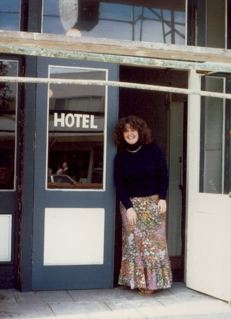 Stepping outside of the San Benito House in the 1970s.
Stepping outside of the San Benito House in the 1970s.
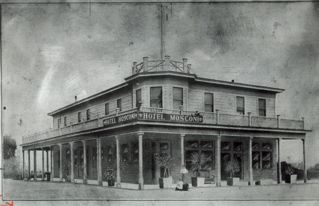
(Center Photo) In an earlier life the San Benito was known as the Moscone Hotel.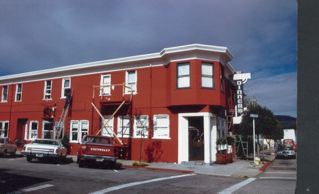 (Photo Below, right) In the 1970s the San Benito House underwent a major facelift.
(Photo Below, right) In the 1970s the San Benito House underwent a major facelift.

Created by June Morrall
The Frick
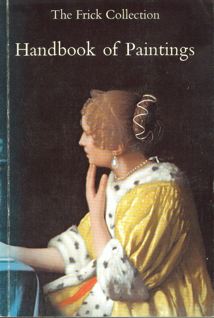
They have the original Vermeer “Mistress and Maid” [1665-70] –seen here. When you see this painting in person, you’ll see the maid she’s having a “conversation” with, and you’ll wonder what they could be talking about. It could be anything–you make it up.
They’ve got Rembrandts & Gainsboroughs & Turners & Whistlers & Titians & on & on, all in Mr. Frick’s historical home. Imagine how he lived while walking through his historical home.. Guaranteed to blow you awayPhoto: The Frick’s garden:
From the(1978) handbook: “The Frick Collection was founded by Henry Clay Frick (1849-1919), the Pittsburgh coke and steel industrialist. At his death, Mr. Frick bequeathed his New York residence and the most outstanding of his many art works to establish a public gallery for the purpose of “encouraging and developing the study of the fine arts.” Chief among his bequests, which also included sculpture, drawings, prints, furniture, porcelains, enamels, rugs, and silver, were one hundred thirty-one paintings. Thirty-eight additional have been purchased over the years by the Trustees from an endowment provided by the founder.
“Mr. Frick grew up in the vicinity of Pittsburg. From an early age he was interested in art, and his acquisitions recorded ov er a span of forty years show a continuing development of knowledge and discernment. After initially concentrating on Salon pictures and works by the Barbizon school, he purchased his first old masters around the turn of the century. In the next decade he acquired many of the distinguished paintings that established the character of the Collection as it is seen today. ….”
The collection will amaze you.
There were times the search for Coastside history led me to the countyâs architecturally uninspiring offices in Redwood City âand one day in the 1970s I was searching for maps of the original ranchos. Of Guerrero, Vasquez and Miramontes.
In the language of acreage, the old ranchos seemed immense: I was anxious to see a map with the actual boundary lines.
An all- business lady wearing a dark suit directed me to an office, identical to the others, but this one was the home of the man Iâll call âthe Keeper of the Mapsâ?.
I got the feeling heâd inhabited this space forever. He knew every townâs outline and shape and what the ..â¦.., ========== and { } meant. All the codes and symbols. He knew the name of every creek and hollow. Heâd lived in San Mateo County all his life and felt a special affection for the Coastside.
He was gracious: âMaps of the original ranchos? Do you want copies?â?
The encounter was brief but the “Keeper of the Maps” made a lasting impression. Someday, I thought, he might make a good story.
Decades later I was ready to write that storyâ it had been a long timeâwas he still tending his maps? was he alive?âAnd in the course of tracking him down, I sadly found his obituary.
Not the first time I had been too late.
But within the obit were the names of siblings. Aha! I thought, Iâll interview one of his relatives.
I’ve had stories take a sharp turn and go in an unexpected direction before–but never one so delightfully surprising.
One of the names was listed in the phone book. I called her, it was the map man’s sister, she was friendly and invited me to her home– one of those endless apartment complexes, hard to tell where it began and ended. Iâd been there before on an interview: a lot of seniors lived quiet, eventless days and nights there.
I can still see her standing at the end of the long, barren hallway. Outside of her apartment, awaiting me.
She was a knockout. I couldnât tell her ageâbut she had to be in her 70s. Her hair was brown, for cut and style, think Barbra Stanwyck. Her skin was smooth and wrinkle-less. I swear!
When she saw my notebook, she warned: âMy daughterâs a lawyer. Watch what you write.â?
She was gorgeous– âNo, Iâve never dyed my hair. No, Iâve never had a facelift, or use botox.â?
She was the sexiest old lady Iâd ever seen. I was stunned. In all my years of interviewing seniors, Iâd never see such a good looking old lady
I explained I was there to talk about her brother, the âKeeper of the Mapsâ?âbut when I asked questions about him, she gave one -word answers and then steered the conversation to herself, shocking me with tales of her active love life.
That night this widow of a prominent businessman was looking forward to a date with a new boyfriend. She couldnât wait. Every time the phone rang, and it did ring several times, she tittered like a teenager hoping it would be him. And one time it actually was.
âI’m not going to tell him I’m 82,â? she said conspiratorially. âHe thinks Iâm in my 70s. I kissed him on our first date.â?
Then, yet another another phone callâthis from a retired television executive whose name I recognizedâ¦he was calling to ask if he could stay the night. Wow!
She made it clear the interview was near an end and I left having made zero progress on my âKeeper of the Mapsâ? story. Not only that but I struck out twice. What I learned about her I couldnât really use; it would have been indiscreet.
Now enough time has passed that I feel I can tell a little about that gorgeous babe.
I didnât learn very much about maps– but I sure learned that some seniors have a torrid love life.
 (Photo: The bandit Tiburcio Vasquez, whose uncle by the same name, owned the Corral de Tierra, stretching from Miramar to Half Moon Bay).
(Photo: The bandit Tiburcio Vasquez, whose uncle by the same name, owned the Corral de Tierra, stretching from Miramar to Half Moon Bay).
The Coastside was so isolated that the bandit Tiburcio Vasquez could visit his uncle on the remote Corral de Tierra without fear of being arrested by the authorities. He was finally captured in San Jose. The sheriff printed invitation announcing his execution on Friday, March 19, 1875.
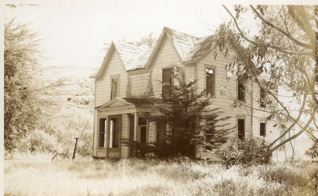 (Photo: Guerrero Farmhouse, later a hotel, Montara)
(Photo: Guerrero Farmhouse, later a hotel, Montara)
Francisco Guerrero continued to spend a great deal of time in San Francisco. In 1850, he was murdered as he stood near the corner of Mission and 12th Streets. The fatal injury occurred when a man stalking him on horseback struck him in the head with a slingshot.
On April 12, 1863, as the ranchero Tiburcio Vasquez sat near a window at a Half Moon Bay saloon, a volley of gunshots rang out. When the dust cleared, Vasquez was declared dead–and the murderers escaped.
It was later reported that there may have been a connection between the Guerrero and Vasquez murders. They had appeared as prosecution witnesses in an infamous land fraud case.
Although Candelario Miramontes did not live to see the outcome of the U.S. war with Mexico, all of his daughter Carmelita’s children were born in the adobe house on Mill Street in Half Moon Bay.
Descendants of these famous early Spanish families still thrive throughout California. Coastside street signs and geographical landmarks carry their names, a constant reminder of Half Moon Bay’s Spanish heritage.
PROSE*
(by Anonymous)
There is no poetry for me.
My years of love to celebrate have passed.
No praise is due for this old body
Never was, really.
Sing the body neglected
I do not live in or near the woods
The Ocean is miles away
Beautiful people no longer visit me
My day is past,
Perhaps it never came
There is one raspy, carping woman, here
Who shouts commands and then complains,
But I would rather forget than herald her.
Occasionally, she goes away.
Then it is quiet.
The neighbors do not speak.
When the doorbell does ring,
Someone wants a contribution
Or a signature
Or I’ve already voted absentee
You can’t see out the dingy windows
It doesn’t matter..
Outdoors it’s always windy, smelly, and gray.
We never see the stars, not up that late.
Too foggy for sun in the morning.
I read the papers
Some books, billboards,
I write uninspired reports and briefs
They are prosaic
There is no poetry for me.
“Anonymous”
(Poet’s name provided upon request)
 (Photo: The Johnston House before it was restored. The historic house is open to the public–check with the HMB Chamber of Commerce for the schedule).
(Photo: The Johnston House before it was restored. The historic house is open to the public–check with the HMB Chamber of Commerce for the schedule).
Few, if anyone, had managed to maneuver wheeled vehicles of any kind over that mountainous barrier. But the Johnston brothers perservered and triumphed over the geographical obstacles by gingerly lowering the wagons with ropes.
Half Moon Bay’s Spanish-speaking residents welcomed James Johnston and his Spanish bride, Petra. He further ingratiated himself with the locals by constructing a real American house, a “saltbox-style” farmhouse that was used as a social gathering place for Spanish and American guests.
Known as the “White House of Half Moon Bay”, the landmark has been beautifully preserved by the Johnston House Foundation.
Miramontes’ adobe house–where his midwie daughter, Carmelita lived after her marriage to Francisco Gonzalez, a ranchero’s son from Pescadero–stood on Mill Street, east of Main in Half Moon Bay. Tiburcio Vasquez built his five-room adobe on nearby Pilarcitos Creek and Francisco Guerrero erected an adobe on a hillside northeast of Princeton.
But it was Vasquez and Guerrero’s huge Corral de Tierra that evoked notions of the romantic Spanish past. Round-up time was the occasion for festive rodeos lasting for days. It was time for celebration. There was feasting and music as the vaqueros vied to prove their superior horsemanship.
While they enjoyed the competition, the vaqueros still had business to do. They lassoed cattle chosen for slaughter, branding the other animals and releasing them to roam for another year on the Corral de Tierra.
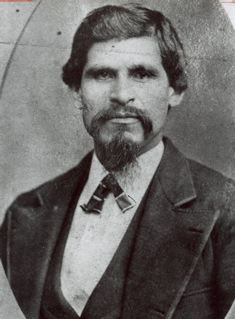 The “bandit” Tiburcio Vasquez, not to be confused with the ranchero by the same name.
The “bandit” Tiburcio Vasquez, not to be confused with the ranchero by the same name.
On one of the happy occasions at the Corral de Tierra, a member of the Miramontes family wa shocked to see the mischievous bandit Tiburcio Vasquez, the ranchero’s nephew. The young bandit reflected the darker side of relations between the Mexicans and their new neighbors, the Americans. This Vasquez thirsted for revenge, scouring the countryside stealing horses and robbing stagecoaches.
Photo: courtesy San Mateo County History Museum. Please visit the museum at the historic Redwood City Courthouse in Redwood City.
…To Be Continued…
“Hi June…I ran into Burt the other day in Burlingame and he told me about
your site…Very Nice!
I have been metal detecting above Surfer’s Beach on the freshly mowed
bluffs and am constantly coming up with lead cargo seals in one area with
the letters O.S. on one side and A.O. on the other. I figure the O.S. is
probably for Ocean Shore (as in railroad), but I’m stumpted about the A.O.
I’ve found about 40 so far. I’m glad to share.
Any thoughts?
Thanks,
Tom Collins” [Montara]
dear june,
sure is fun checking in with your wonderful site. keep on keeping the coastal memories alive and kickin’.
just saw my name mentioned in a complementary context — thank you, fayden!
anyone remember orville, the ex-seal and appliance repairman? will never forget my arm wrestling match with him at the miramar beach inn….”
and in an earlier email, peter wrote:
“june,
it’s great seeing old friends on your site, the likes of richard english, richard henry, chad, fayden, ann bauer, chuck bodin, michael powers, charles nye, etc.. did you know cherie hooper, orville, michael and rocky mc clure, sharon miller, caroline wood, the band stagecoach, tom neel — all names from the miramar days when john, and i worked on the remodeling. had dinner on a visit up there a
few weeks ago and was astonished to see most of my glasswork still there…”